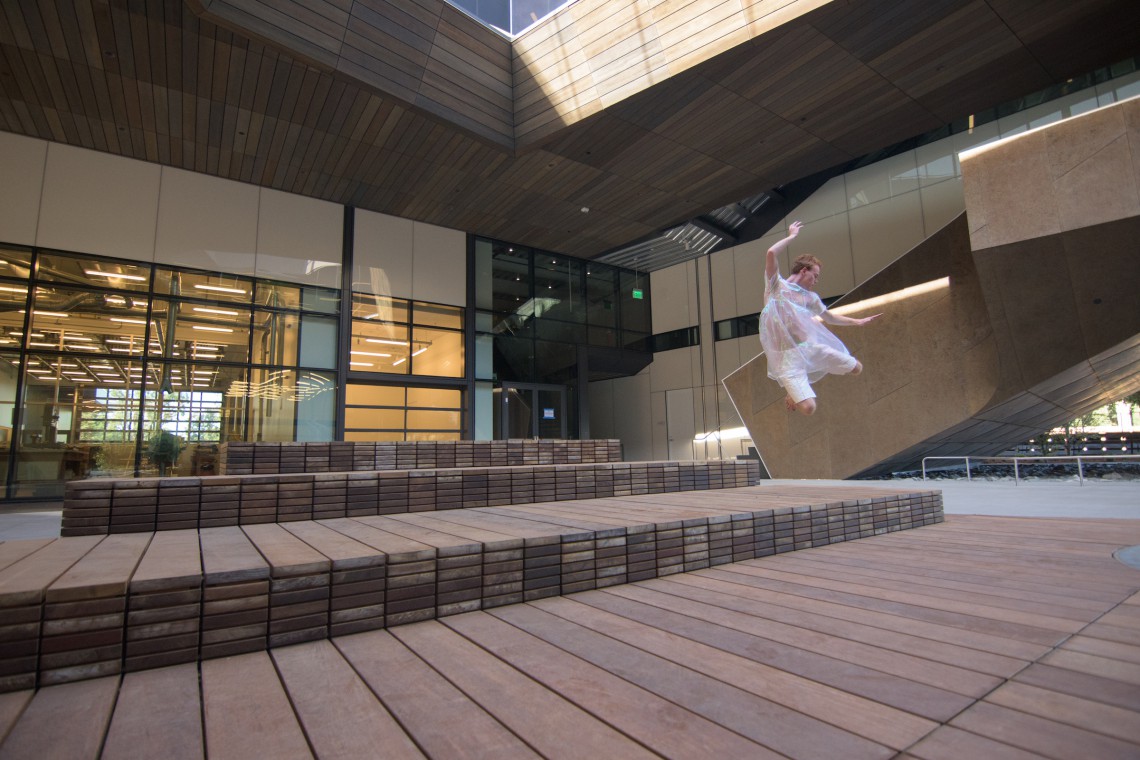
Male dancer in midair leap.
Dancer rehearses in the McMurtry Building atrium.Stanford performances and symposium highlight architecture
Stanford continues to be the "it" place for architecture with upcoming dance performances on Nov. 7-8 and a symposium on Nov. 13 with international experts.
It has been weeks since the last hard-hat spotting in the arts district, but buildings remain in the spotlight at the corner of Roth Way and Lomita Drive.
This weekend, architecture will be considered and celebrated through the medium of performance. Building Scene: Space Launch, performed by the Chocolate Heads Movement Band, is a dance and performance installation commemorating the opening of the McMurtry Building, home of the Department of Art & Art History. Two free, public performances are scheduled this weekend in the building’s courtyard at 3 p.m. on Nov. 7 and 8.
Building Scene was conceived and directed by Aleta Hayes, lecturer in dance, with choreography by Hayes, Adwoa Boakye and the Chocolate Heads. Hayes said that she and the Chocolate Heads have created an effusive piece that will use live DJ music and over 20 performers in 19 embodied vignettes to move the troupe and audience through Charles Renfro’s kaleidoscopic building.
Charles Renfro, architect of the McMurtry Building and partner-in-charge of Diller Scofidio + Renfro, delivered the Cantor Arts Center’s Bobbie and Mike Wilsey Distinguished Lecture in October, where he spoke about the design philosophy behind his body of work, including the McMurtry Building.
Regarding Building Scene, Renfro said, “The McMurtry Building is intended to be something of a provocateur. It foregrounds movement and puts it on display. It pits two sides of movement and stasis against each other. But it provides stages of interaction between the two sides on three different levels: courtyard, library, skycourt. Art history, studio art. Introvert, extrovert. Clean, dirty. Boy, girl. It is the perfect mise-en-scene for a pas-de-deux.”
Piranesi at Stanford
At 9:15 a.m. on Nov. 13, Fabio Barry, assistant professor of art and art history, will convene four international experts for the symposium “Piranesi, Paestum and Soane.” The event will take place in the Cantor Arts Center while the exhibition, Piranesi’s Paestum: Master Drawings Uncovered, is on view on campus through Jan. 4, 2016.
Piranesi was renowned as an engraver of ancient architecture and as an armchair archaeologist. This gathering will focus on the theoretical legacy of Piranesi exemplified in his drawings of the Greek temples at Paestum. It is free and open to the public.
“After more than 200 years, Piranesi’s drawings still raise so many questions that it is wonderful that our colleagues in the Department of Art & Art History decided to bring the scholars together who can shed more light on them,” said Wim de Wit, the Cantor’s first adjunct curator of architecture and design.
Barry commented, “I am delighted that the Cantor organizes exhibits like this, which become the occasion for scholarly gatherings and continue the conversation across the lawn between McMurtry and Cantor. I look forward to future collaborations.”
The symposium topics will range from the European debate over the most primitive and therefore most authentic origins of architecture to the English architect Sir John Soane’s own engagement with Piranesi through his architectural designs and drawings of Paestum, to the influence of Piranesi on early American architecture and urban planning.
Alexander Nemerov, chair of the Department of Art & Art History, will deliver welcome remarks to open the first session in the Cantor Arts Center Auditorium. Morning speakers are Heather Hyde Minor, University of Notre Dame, and Maarten Delbeke, University of Ghent. After lunch, speakers in the second session located at the McMurtry Building are Mark Rakatansky, Columbia University, and Mario Bevilacqua, University of Florence. Barry will deliver the closing remarks. A reception follows at 3 p.m.
In October, the Cantor also hosted a panel discussion on architectural drawing – both analog and digital – as a tool in the design process and as an object worth collecting and putting on display.
De Wit moderated the panel “Drawn to Build: Architectural Representation in the Digital Age,” which was organized in conjunction with the Piranesi exhibition. Speakers were Sergei Tchoban, managing partner of the architectural firm nps tchoban voss and founder of the Tchoban Foundation – Museum for Architectural Drawing in Berlin, and Andrew Zago, partner and founder of the firm Zago Architecture in Los Angeles.
Reflecting on the discussion, de Wit said it was fascinating to see the differences between the two speakers. Tchoban, he said, saw the drawing purely as a work of art, while Zago discussed the drawing as an intellectual construct.
